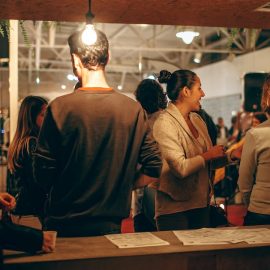

This article is an excerpt from the Shortform book guide to "Do Nothing" by Celeste Headlee. Shortform has the world's best summaries and analyses of books you should be reading.
Like this article? Sign up for a free trial here.
Do you feel pressured to produce? Are you overworking and “underliving”?
In Do Nothing, Celeste Headlee argues that, by trying to do too much, people are working less efficiently. This is because the human brain isn’t designed to multitask and work without rest. Even more, the culture of overworking has led to worse health outcomes and more social isolation.
Continue reading for an overview of this book that shows you how to free your life from the tyranny of work.
Overview of Do Nothing (Celeste Headlee)
In today’s fast-paced world, our lives increasingly revolve around productivity, efficiency, and work. It’s now normal for many people to answer emails during dinner and pack their days with as many tasks as possible. But, since all this work isn’t serving us, how can we end an addiction to productivity? And, if not work, what should we be doing? In Do Nothing, Celeste Headlee offers a solution. It isn’t exactly to “do nothing” (as the title suggests) but to embrace true leisure—doing things just for the fun of it and not to achieve a specific goal.
Headlee is a radio journalist of over 20 years and the author of the best seller We Need to Talk (2018), as well as Speaking of Race (2021), and You’re Cute When You’re Mad (2022). Her TED Talk titled “10 Ways to Have a Better Conversation” went viral in 2015, launching her career as a public speaker on topics ranging from communication to music. Headlee decided to write Do Nothing (2021) after struggling with work burnout, despite gaining financial stability and self-employment. By sharing her experience and research on this topic, she hopes to help others like herself end an unhealthful addiction to productivity.
We’ll explain how economic changes during the Industrial Revolution sparked a major shift in work culture that persisted into the modern age, discuss how the cultural emphasis on productivity impacts people today, and lastly, cover Headlee’s tips for changing the way you work and making space in your life for leisure and human connection.
The Historical Origins of Overworking
Headlee writes that the culture of overworking can be traced back to the Industrial Revolution—a period of rapid technological advancement in Europe and the US beginning in the 1700s. During the Industrial Revolution, inventions such as the steam engine drastically changed the way people lived and worked due to the proliferation of factories, which quickly became a common place of employment. During this period, many people migrated to cities for work.
Headlee identifies two specific factors that encouraged people to prioritize work during this industrial era: 1) the economic pressure to work more due to the rise of wage labor and 2) the cultural pressure to work hard, which stemmed from Protestantism and the American dream narrative. Together, Headlee argues, these economic and cultural factors spurred people to work more hours than humans had ever done historically. In this section, we’ll break down each of these factors and how they played a part in the work culture we inherited today.
Economic Pressure: Wage Labor During the Industrial Revolution
Headlee explains that before the Industrial Revolution, more people had access to land that they could live off of, and many people worked in trades such as carpentry. However, during the Industrial Revolution, those options dwindled as a small upper-class consolidated land ownership. This reduced other people’s access to land, and factories cheaply mass-produced products, making it increasingly difficult for artisans to sell handmade products.
Headlee posits that, as more people were forced to move from rural areas to cities to find work, the economic autonomy of the working class declined sharply, and people had to work longer hours to meet their basic needs. For example, instead of working on chores that were done as needed, like taking care of livestock and gardens, people had to trade their time for money and had little control over their working conditions, wages, and schedules. Workers had to meet the demands of their employers, often in unpleasant factory environments, or risk losing their jobs and livelihoods.
Headlee writes that, during this time, people started working 10 to 14 hours per day on monotonous tasks. By contrast, medieval peasants worked a maximum of eight hours per day and took about a third of the year off. This example and other historical reference points reinforce the idea that industrialization significantly increased the number of work hours required to survive.
Power Struggle Between Laborers and the Economic Elite
In contrast to the loss of autonomy for working-class laborers, the wealthy business-owning class benefited from cheap labor and the massive profits from selling retail products like clothing and household goods. As a result, they leveraged their power to exploit laborers by forcing people to work long hours for as little pay as possible.
Headlee says that, around the turn of the 20th century, labor unions started forming to curb employers’ power and implement policies like the eight-hour workday. Despite the fact that police and the military often responded to strikes with violence, people in the US, Europe, and other regions fought for improvements to working conditions and limited work hours.
Headlee explains that, when faced with these limitations (around the turn of the 20th century), the wealthy class then shifted their attention to new strategies to encourage people to work more. Some of these were internal, company-level strategies like dangling promotions to encourage workers to compete with one another by working harder. The wealthy class implemented other methods to change how people thought about work in general.
Cultural Pressure: Work as a Virtue and the American Dream
Headlee says that the American elite exerted cultural pressure on people to work more by promoting the Protestant idea that hard work is virtuous as well as the narrative of the American dream—the idea that you can rise through the ranks and get rich if you work hard enough. Although the Protestant church had been teaching that hard work is a virtue in the eyes of God (while idleness is a sin) since the 1500s, a 1904 book by the German sociologist Max Weber inspired capitalists to revive the idea in American culture to get people to willingly work longer hours.
In the book—The Protestant Ethic and the Spirit of Capitalism—Weber argued that linking morality to work was what fueled the booming capitalist economy in Europe in the industrial era. Thus, upper-class Americans decided to use this tenet for their own financial gain as well. For example, Headlee suggests that in 1901, a prominent Episcopal leader received millions of dollars in donations from the financier J.P. Morgan to preach that wealth demonstrates that a person has good character (thereby encouraging people to work harder so upper-class employers could make more money).
According to Headlee, employers also made people feel ashamed for taking time off or being idle and convinced laborers to work more by espousing stories of the “self-made man” and the idea of the American dream, in which people could become rich and improve their quality of life through hard work alone. Employers used propaganda such as posters and slogans to link hard work with morality, patriotism, and economic success—a technique that first became popular during World War I.
One example of this is a series of posters called the Mather Work Incentive Posters, which said things like, “Floaters Always Float Down Stream. The worker who drifts from one job to another, is always headed down-and-out. To get up and on, requires real effort, real work. The good places are all up stream.”
Headlee writes that, in addition to using posters and slogans to encourage work, business owners had to figure out how to sell all the new products that workers were helping to make, so the marketing industry put additional pressure on people to make more money and keep up with consumer trends by buying new products.
The Productivity-Obsessed Culture of Today
Fast-forwarding to the modern age, Headlee says that the cultural obsession with a strong work ethic that started during the Industrial Era persists today, causing many people to choose to overwork themselves. Many people still view hard work as a sign of good character, and when asked how they’re doing, “busy” is often the response that signals how important and valuable they are as a person (even if it’s stated in a complaining tone). As a result, many people willfully work far more than is necessary to survive.
However, Headlee shares a caveat to her assertion that people are choosing to overwork: This trend doesn’t apply to the many people who are involuntarily unemployed or underemployed (meaning they don’t get enough work hours to meet their needs). Many people don’t have the luxury of choosing to work less because they’re struggling to get by.
Headlee writes that the modern pressure to constantly be productive largely stems from changing perceptions of how valuable one’s time is and the pressure to achieve a more glamorous lifestyle. She also points out the higher expectations on women to both have a successful career and take care of their families.
Time Feels Scarce and Too Valuable to Squander
Although people aren’t working longer hours on average compared to the Industrial Revolution era, they still feel exhausted and overworked. Headlee says this is partly because as someone’s hourly wage or salary goes up, their time becomes more valuable. And because time is more valuable, it also feels more scarce. Thus, people feel anxiety at the prospect of wasting time by not doing something productive.
As a result, the urge to be productive spills over into people’s non-professional lives, so even when people aren’t at work, they feel like they should be still pursuing self-improvement or self-advancement. This means that activities that should be relaxing, like meditating, often become tiresome and stressful because people overanalyze the activity with an app, or post it on social media to impress others. In other words, activities turn into work when they’re goal-oriented instead of being done just for the sake of enjoying life in that moment.
Chasing Economic Advancement and Social Status
Headlee argues that another reason behind the modern obsession with work is the pressure to achieve a more luxurious lifestyle by working hard and making more money. The narrative of the worker who gets rich by never taking a day off dates back over a hundred years. The problem with this, Headlee says, is that social media causes people to chase ever more glamorous lives as they compare themselves not only to the people around them but to the billionaires and millionaires that take up a disproportionate amount of media space.
Headlee also points to capitalism and the psychology behind consumerism as driving forces behind the compulsion to work more to buy things. To keep the economy growing, people have to keep spending money, so the marketing industry continues to put enormous amounts of resources into making people feel like they need to buy products to be happy.
Headlee notes that, psychologically, people do get a boost of happiness when they get something new. Unfortunately, when the novelty wears off, they need another new thing to feel that joy again, so what someone has never feels like enough. The same vicious cycle occurs with people’s salaries as a result of what psychologists call the “hedonic treadmill”—the phenomenon in which humans go back to a baseline level of happiness after something good (or bad) happens.
Women Experience Additional Pressures
Headlee also argues that women are disproportionately burdened by the modern work culture because they’re expected to do more unpaid domestic labor (such as cooking, cleaning, and childcare), often while working outside of the home for less pay on average. Headlee writes that women with children tend to be paid less than women without children, while the opposite is true for men. This means that many women have more economic pressure and more family duties to juggle on top of the cultural expectations to be ultra-productive at work and outside of work.
The Negative Consequences of Working Too Much
Now that we’ve described the nature of the modern work culture, we’ll explain how working too much becomes counterproductive in many ways. Headlee argues that the work-obsessed culture has led to lower efficiency, worse mental and physical health, and an unhealthful addiction to technology.
Lower Efficiency
One of the main ways people try to fit more into the day is by multitasking—for example, responding to emails and text messages as they come in while also working on writing a report and scrolling through social media. Yet Headlee says that instead of getting more done at once, people take more time to do each task than it would take if they focused on one thing at a time. This is because, despite our best efforts, the human brain isn’t capable of multitasking. Instead, we take extra time constantly switching between different tasks.
In addition to trying to multitask, people often work long hours, thinking they’ll get more accomplished or impress their boss by showing how hard they work. However, Headlee says that although many companies measure productivity by work hours, research shows that people work more efficiently when they work fewer hours and take frequent breaks. This is because people can only do about an hour of focused work at a time on average.
And, Headlee adds, we tend to make a task length stretch to the amount of time available to do it. Therefore, working long hours can lead to inefficiencies like taking a whole workday to complete a task that could have been done in a few hours (with breaks in between) if given a strict stopping point.
Worse Mental and Physical Health
Although many people state that they enjoy work or they feel better when they’re being productive, Headlee counters that this is partly due to the cultural conditioning that shames people into working hard, when the reality is that overworking has a negative impact on people’s mental and physical health.
Headlee cites research that says that half of all visits to the doctor in the US are linked to stress-related health problems, and Headlee attributes this trend to the rise in work and productivity-related stress. Research indicates that feeling stressed about not having enough time can lead to insomnia, anxiety, lower levels of happiness, and obesity. In contrast, companies that reduce work hours tend to maintain productivity while improving the emotional and physical health of their employees.
Unhealthful Technology Usage
Another downside of prioritizing productivity above all else is that it tends to make technologies that enable productivity—like smartphones—an integral part of people’s day-to-day lives. Headlee argues that this, in turn, has a slew of negative consequences.
One major impact of the frequent use of technology is that it allows work to seep into people’s personal lives when they’re off the clock. Smartphones and laptops enable people to stay connected 24/7, and as a result, there’s more pressure to respond to work emails and phone calls even when someone is meant to be enjoying time off. This means that there’s less separation between on-the-job time and off-time, and many people feel like they can never fully relax.
Another impact of the constant use of technology is that it interferes with sleep patterns because the blue light emitted from screens tricks your brain into thinking that it’s daytime (and therefore time to be alert). This hinders the release of the hormone melatonin, which helps you sleep.
In addition, Headlee says that digital device notifications stimulate a physiological fight-or-flight response, which releases stress hormones. Simply having your smartphone near you, and therefore having the possibility of receiving a notification, can distract you from being present.
Lastly, Headlee writes that the frequent use of social media is (ironically) causing social isolation. Instead of having deeper relationships with a smaller circle of friends, people are replacing those relationships with an overwhelming number of superficial, digital connections. Headlee says that a person’s social media network tends to include too many people to genuinely empathize and keep in contact with. In addition, digital interactions are less intimate than in-person and vocal interactions, so the countless digital exchanges that people have daily are less emotionally gratifying.
How to Live a Healthier Life
Given the negative consequences of a productivity-obsessed culture—the inefficiency and the tolls it takes on people’s minds and bodies—Headlee concludes that working more than we need to support ourselves simply isn’t good for us. She explains that she experienced many years of struggling financially as a single mother, and even when her career started to provide financial stability and the flexibility of self-employment, it wasn’t enough to relieve her stress around work and time. She realized that it wasn’t her boss or her smartphone that fundamentally caused her problem but the cultural norms and expectations that encouraged her to willfully overwork herself.
Based on her own experience making positive changes to the way she lives and works, Headlee advises on how to live a healthier life—with ample leisure and social connection—by being more intentional about how you spend your time (she refers to these tidbits of advice as “life-backs,” as a play on the phrase “life hacks”).
Change Your Mindset
The first way to improve your mindset around productivity and time is to increase your awareness of how you spend your time. Headlee says that, by keeping a log of how you spend your day, you’re likely to discover that you have more time than you thought you had to get everything done. Realizing that you do have enough time to get all the essentials done will greatly reduce your stress levels and anxiety around time. It might also help you pinpoint aspects of your schedule you’d like to change—for example, if you notice that you spend far more time on social media or writing emails than you thought you did.
The next mindset shift Headlee describes is focusing on larger goals rather than the steps you take to achieve the goals. She explains that we often get too caught up in a goal’s metrics or stepping stones, to the point that we forget about the ultimate reason for doing something.
For example, perhaps you want to feel healthier, so you start a strict yoga class regimen. However, if missing a session makes you feel stressed, or you force yourself to go even when you don’t feel physically up for it, the activity can become counterproductive to your initial goal. Instead, it might be better for your health to keep the class schedule flexible and take days off when your body needs rest. Headlee says that while metrics can be helpful, remember that there are many ways of reaching a goal, so focus on what’s important to you in the long term.
Change Your Scheduling and Work Habits
Headlee’s next tips are for changing your scheduling and work habits. Her first piece of advice is to do more focused work so that you can work fewer hours while getting the same amount done. If you have flexibility in your schedule, she recommends working for about 50 minutes at a time, followed by a short break to recharge.
Headlee also recommends not working any more than your job requires, since the accompanying stress and exhaustion from being overworked isn’t worth the career-related benefits you may or may not get from it.
Another work-related tip is to work in groups when you can. Headlee says that although many people feel that working independently is more efficient, research suggests that diverse groups are more efficient at problem-solving and making optimal decisions compared to individuals. Thus, collaborating with others can save you time and produce better results.
Lastly, create your dream schedule and include ample leisure time. Headlee says your dream schedule doesn’t have to be strictly followed, but writing it down will give you something to strive for. Remember to include leisure activities—anything that’s purely for enjoyment like going for a walk, reading outside, doing a craft, or playing music.
Having these periods of rest is essential because it improves mental health and activates a state of mind known as the default mode network (DMN). The DMN activates when your brain isn’t working on a task, and in this state, we naturally process emotions and decisions, reflect on memories, think about how others feel, and daydream about the future. Headlee says that the DMN sparks creativity and growth since our brain is free to consider things from new angles.
Change How You Interact With Others
Headlee’s next set of advice for achieving a healthier life centers around your interactions with others. First, avoid making unhealthful comparisons about your productivity. Headlee asserts that your perception of how busy other people are is likely inaccurate anyway since many people try to outdo one another when it comes to busyness. In addition, she says that comparing yourself to someone online can be unhealthful because they might have a lifestyle that’s unobtainable—like celebrities, for example—and the comparison is more likely to make you feel bad than it is to inspire you.
Another way to improve your well-being and avoid some of the pitfalls of overworking is to schedule social time and make an effort to interact in person with others. Headlee asserts that while many people use technology to avoid conversations and small talk with acquaintances and strangers, these small social interactions—like chatting with your mail carrier—improve your health and make you feel more relaxed. As we mentioned earlier, deeper relationships are also important, so set aside time to regularly catch up with friends and stay connected with loved ones.
Headlee’s last recommendation is to do a small act of kindness every day to counteract the lack of social connection and mental-well being that overworking causes. This could include cooking a meal for someone, or something small like giving a sincere compliment. Acting kindly and generously toward others not only helps the recipient but also makes the person doing the act feel happier and less stressed. Headlee explains that humans are social creatures (we thrive in communities, not in isolation), so we evolved to receive psychological benefits from altruism, which increases social cohesion. Plus, these benefits have a ripple effect because the recipient is more likely to do something nice for someone else, too.

———End of Preview———
Like what you just read? Read the rest of the world's best book summary and analysis of Celeste Headlee's "Do Nothing" at Shortform.
Here's what you'll find in our full Do Nothing summary:
- How our fast-paced world is causing us to work less efficiently
- How the culture of overworking has led to social isolation and poor health
- How to embrace true leisure to live a happier and healthier life






